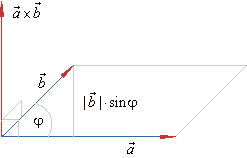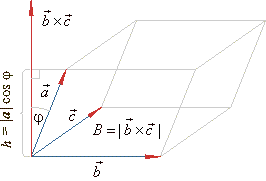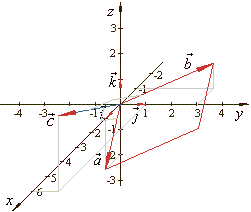|
|
|
|
ALGEBRA
|
|
|
|
::
Vector
product or cross product
|
|
The vector product of two vectors,
a
and b
is the vector
a ´
b perpendicular to given vectors, and the
magnitude of which
|
| |
a ´
b
|
= | a | · | b | · sinj,
where j is the angle between
a
and b. |
|
That is, the vector product
a ´
b is the vector magnitude
of which equals the area of a parallelogram with sides a
and b, and the direction
of which is perpendicular to the plane of the given vectors, forming a
right-handed system as is shown in the below diagram,
|
 |
|
A right-handed system is so called because
vectors,
a ,
b
and a
´
b have
the orientation of the thumb, the forefinger, and the middle finger of the right
hand.
|
|
That is, if the thumb is placed in the
direction of the first operand (a)
and the forefinger in the direction of the second operand
(b), then the resultant vector
(a
´
b)
is coming out of the middle finger.
|
|
 |
|
|
|
An example for the vector product in physics
|
|
An example for the vector product in physics is
a torque (a moment of a force - a rotational force). |
|
The force applied to a lever, multiplied by its distance from the lever's fulcrum
O,
is the torque
T, as
is shown in the diagram.
|
|
|
|
|
The
vector product is not
commutative,
that is
|
|
|
|
|
The vector products of the standard unit vectors
|
|
|
|
The vector product
properties
|

|
|
The vector
product in the component form
|
 |
 |
| The
above component notation of the vector product can also be written formally as a symbolic determinant expanded by minors
through the elements of the first row. A minor is the reduced determinant formed by omitting the
i-th row and
j-th column of a matrix, multiplied by
(-1)i
+ j. |
 |
|
|
|
::
The mixed product
|
|
The
mixed product or scalar triple product definition
|
|
The
mixed product (or the scalar triple product) is the scalar product of the first vector with the vector product of the other two
vectors denoted as a
· ( b ´
c ).
|
|
Geometrically, the
mixed product is the volume of a parallelepiped defined by vectors,
a ,
b
and c
as shows the right figure.
|
The vector b
´
c is perpendicular to the base of the
parallelepiped and its magnitude equals the area of
the base, B =
| b ´
c
|.
|
The altitude of the parallelepiped is projection of the
vector a in the direction of
the vector
b ´
c,
so
|
| h =
| a | · cos j.
|
|
 |
|
|
Therefore, the scalar product of the vector
a
and vector
b ´
c
is equal to the volume of the parallelepiped.
|
 |
|
The sign of the scalar triple product can be either positive or negative, as
a
· ( b ´
c ) =
-
a
· ( c ´
b ).
|
|
|
The
mixed product properties
|

|
|
The condition for
three vectors to be coplanar
|
|
The
mixed product is zero if any two of vectors, a ,
b
and c
are parallel, or if a ,
b
and c
are coplanar. That is,
when the given three vectors are coplanar the altitude of the parallelepiped is zero and thus the scalar triple
product is zero, |
 |
|
|
The
mixed product or scalar triple product expressed in terms of components
|
| The scalar triple product expressed in terms of the components of vectors,
|
| a =
axi + ay j + azk,
b
= bxi + by j +
bzk
and c
= cxi + cy j +
czk, |
 |
| The above formula can be derived from the determinant expanded by minors through the elements of the
first row, |
| Therefore, vectors,
a,
b
and c
will be coplanar if this determinant is zero. |
|
 |
|
|
|
|
The vector product
and the mixed product use, examples
|
|
Example:
Given are vectors, a
= i -
2 k and
b =
-
i + 3 j + k, determine the vector
c
= a
´
b
and the area of a parallelogram formed by vectors, a
and b.
|
|
Solution: |
 |
|
|
 |
| The area of the
parallelogram, |
 |
| or |
 |
|
 |
|
|
|
Example:
Find the angles that
the unit vector, which is orthogonal to the plane formed by vectors,
a
= -i +
2 j + k
and b
= 3i -
2
j + 4k,
makes with the coordinate axes.
|
|
|
|
Example:
Given are vectors,
a
= -3i +
4 j -
l
k,
b
=
2i -
j + k
and c
= i
-
4 j -3l
k,
determine the parameter l
such that vectors to be coplanar.
|
|
Solution: Vectors lie on the same plane if their scalar triple product is zero, i.e.,
V =
0, therefore vectors’
coordinates must satisfy the condition,
|
 |
|
|
|
|
|
|
|
|
|
|
|
|
|
|
|
|
|
|
|
|
|
|
|
|
|
|
|
|
Contents
B
|
|
|
|
|

|
|
|
|
|
|
Copyright
© 2004 - 2020, Nabla Ltd. All rights reserved.
|
|
|